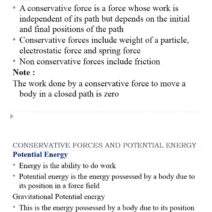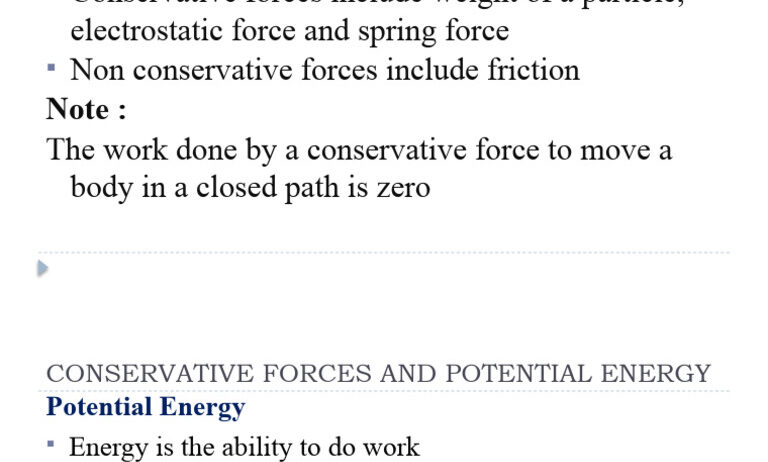In the vast expanse of classical mechanics, the concept of potential energy stands as a fundamental pillar, entwined with our understanding of forces that operate within the universe. The inquiry into whether potential energy depends on conservative forces unveils a captivating tapestry, weaving together principles of physics, mathematical elegance, and real-world applications that extend from simple machines to complex ecological interactions. This discussion voyages through foundational concepts, navigating the intricate relationship between conservative forces and potential energy.
To embark on this exploration, it is crucial to define what is meant by potential energy. Potential energy is often characterized as the stored energy resulting from an object’s position or configuration. In most discussions, gravitational potential energy serves as the archetype: an object elevated within a gravitational field possesses energy attributable to its altitude. This energy is not merely a number; it signifies the ability to perform work when an object is allowed to move back to a lower state, such as when a falling apple delivers nutrients to the earth below.
What elevates this discussion further is the notion of conservative forces—forces that maintain a consistent relationship with potential energy. These forces, exemplified by gravity, elastic force in springs, and electrostatic forces between charged particles, possess a distinct characteristic: the work done by or against these forces in a closed path is zero. Therefore, the work done from point A to point B does not depend on the path taken but solely on the initial and final positions. This fascinating property not only facilitates a more profound comprehension of work and energy but culminates in derived equations that delineate the quantification of potential energy.
The connection between conservative forces and potential energy becomes palpable through mathematical expressions. Consider the equation for gravitational potential energy, which can be articulated as:
PE = mgh
Where “PE” is potential energy, “m” is mass, “g” represents the acceleration due to gravity, and “h” is the height above a designated reference point. Here, gravitational force is inherently conservative, as it not only dictates the nature of potential energy but also ensures that the work done in climbing or descending is reversible, affirming the delicate equilibrium inherent in nature’s design.
As one delves deeper, it is essential to engage with the implications of potential energy in various contexts. Beyond mere abstraction, the applications of these principles permeate multiple domains—engineering, environmental science, and even conservation efforts. For instance, renewable energy technologies harness potential energy through gravitational systems, such as pumped storage hydropower stations, whereby water is elevated to a height and subsequently released to generate electricity. Understanding how conservative forces interplay with potential energy is paramount for optimizing energy transitions—critical as the global community combats climate change.
Furthermore, the relevance of potential energy extends beyond human-made systems. Ecological systems exemplify this relationship uniquely. Trees, as they grow, accumulate potential energy in their branches and leaves. As these natural structures undergo seasonal changes, they liberate this stored energy through processes of decomposition and nutrient cycling, thereby fostering a regenerative cycle that underscores the importance of biodiversity and resilience in facing environmental challenges.
To intensify curiosity regarding potential energy, one must explore the less apparent implications of this relationship. Imagine scenarios where conservative forces are absent or fail to conform to their expected behaviors, such as in non-conservative forces like friction. This deviation from typical patterns introduces complexities that confound straightforward potential energy calculations. While conservative forces allow for a predictable and tidy approach to energy transformations, non-conservative forces such as friction and air resistance dissipate energy in forms that do not contribute to mechanical work, leading to heat loss and inefficiencies. Thus, the dependency of potential energy on conservative forces emerges not only as a vital aspect of physics but also as a lens through which the duality of efficiency and loss can be examined critically.
The idea of gravitational potential energy offers a captivating metaphor for societal progress and ecological stability. Much like an object poised to fall from a height, societies laden with knowledge and technology have the potential to enact significant change. However, the existence of conservative forces in this context—ethical standards, scientific advancements, communal support—can either facilitate a smooth descent into sustainable practices or hinder progress through inertia or resistance.
As scholars and activists scrutinize the implications of potential energy, the overarching question emerges: What does this mean for our future? The relationship between potential energy and conservative forces underscores the delicate balance necessary for advancing environmental sustainability. By harnessing the principles of potential energy within the frameworks provided by conservative forces, societies can innovate better solutions to mitigate climate change impacts, transitioning toward renewable and sustainable practices.
In conclusion, the inquiry into whether potential energy depends on conservative forces not only underscores the fundamental interactions within our physical universe but also highlights the broader implications for engineering and environmental sustainability. The story of potential energy is one of possibilities and consequences, urging both scientific inquiry and societal reflection. This exploration not only promises a deeper understanding of physics but also invites a collective contemplation on how we navigate our world. Thus, as one contemplates the delicate balance of forces that govern energy, the symbiotic relationship between potential and kinetic forms beckons us to ponder the paths we choose, the forces we harness, and the energies we reserve for the future.






